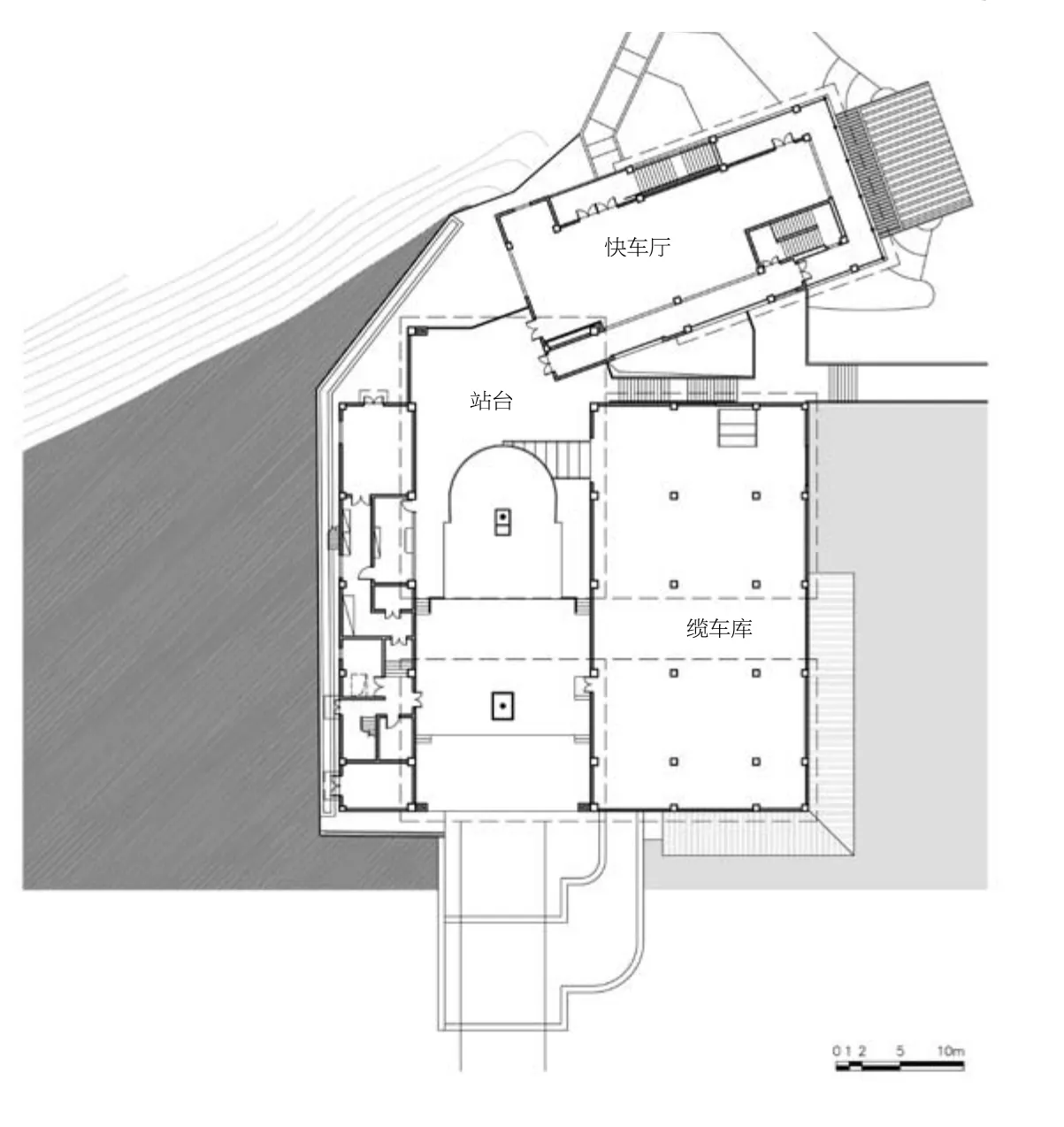笔架山景区一期服务设施,井冈山,江西
2015-12-21建筑设计韩冬青东南大学建筑设计研究院有限公司ArchitectsHANDongqingArchitectsEngineersCoLtdofSoutheastUniversity
建筑设计:韩冬青/东南大学建筑设计研究院有限公司Architects: HAN Dongqing/Architects & Engineers Co., Ltd. of Southeast University
笔架山景区一期服务设施,井冈山,江西
Phase-I Infrastructures of Bijiashan Scenic Spot in Jinggang Mountain, Jiangxi, China, 2008
建筑设计:韩冬青/东南大学建筑设计研究院有限公司Architects: HAN Dongqing/Architects & Engineers Co., Ltd. of Southeast University

1 下站房和游客服务中心鸟瞰/The aerial view of Bottom Station & Tourist Reception Centre
该项目位于中国江西省的国家级风景名胜区井冈山的笔架山景区。笔架山景区以绮丽的高山景观和亚热带植物多样性为特色。游客接待中心和建于不同高度的3个索道站房是笔架山景区开发中基础设施建设的一期工程。其中,游客接待中心位于进入景区的主入口。索道站房的功能包括游客候车、缆车库房、设备机房、控制室、办公、茶室和贵宾接待等。建筑设计的构思基于对两个关键问题的思考:其一,如何使建筑与山形地貌和景观建立起最恰当的形态联系?其二,如何延续乡村的建造文化并使之满足新功能和技术的要求?
建筑的基地位于地形变化十分复杂的山坡上。在尽力维护原地形高差、树木、水体等环境要素的基础上,设计借鉴台地建造和干阑建造的传统,采用小体量组合的方法。小尺度策略弱化了建筑自身的表现,从而使自然景观成为这里的主角。为保护和延续日渐式微的民间建造文化,建筑师采用了乡间传统的木构技术。应对索道机械设备所产生的动力荷载及基地潮湿的气候,设计选择了钢筋混凝土框架结构作为建筑的基座,其上叠加民间木构。就地取材的竹、石、砖瓦被组合运用,强化了建筑作为地方景观的认知影响力。这些建筑的木构部分由地方工匠完成,他们的劳动为建筑注入了更多的文化感染力。
该项目设计的核心议题是自然景观的保护和地方文化的延续。项目组投入数月的时间理解山地景观的结构和要素,对当地的村落和民居进行了深入的调查和研究,探寻了地域传统聚落的自发生长方式和建造技术特征。设计基于整体景观的形体处理、传统地方木构与现代钢筋混凝土框架结构的组合和地方材料的运用,表现了自然优先和自明建构的设计理念。□

2 上站房室外平台/Outdoor platform (Upper Station)

3 笔架山景区入口服务区规划总平面/Site plan, the phase 1 of development of Bijiashan Scenic Spot
The project is located at Bijiashan Scenic Spot of Jinggang Mountain Scenic Area, a National Scenic Area in Jiangxi Province of China. The area features attractive mountain scape and diversified subtropical plants. The Phase-I project of the infrastructures construction in the development of Bijiashan Scenic Spot is composed of a tourist reception center and three cable stations built at different altitudes. The tourist reception center is set at the entrance of the scenic area. The functions of the cable stations include a tourist waiting space, a cable car storeroom, an equipment room, a control room, an office, a tea room, and a VIP reception. The design is based on the consideration of two key questions: first, how to establish the most appropriate morphological connection between the architecture and the mountainous landforms? Second, how to maintain the rural construction culture and make it fulfill the demand of new functions and techniques?
The base of the building is located on the hillside where the landform is quite complicated. On the basis of preserving to the maximum extent various environmental elements such as altitude disparity, trees and waters, the design borrows from highland and stilts construction traditions, and uses the combination of small structures. The small-structure strategy reduces the sense of architectural presence, thus affording the leading role to nature. In order to protect and maintain the increasingly declining local construction culture, the architect adopts the traditional wooden structural techniques. To cope with local humid climate and the dynamical load produced by the cable machinery, the design chooses reinforced concrete structure as the base of the building, with local wooden structure layered over. The mixed application of such local materials as bamboo, stones and bricks strengthens the cognitive influence of the construction as a part of the local landscape. The wooden structure of the building is completed by local craftsmen, whose work adds more cultural appeal to the architecture.
The central theme of the design is the preservation of natural landscape and the sustaining of local culture. The project team spent several months on understanding the structure and composition elements of the mountain landscape, conducted in-depth survey and research on local villages and houses, and explored the spontaneous growing mode and construction features of the region's traditional settlements. Every aspect of the project, from the morphology design based on the overall landscape, to the use of local materials and the combination of traditional wooden structure with modern reinforced concrete framework, reflects a central design concept, i.e. giving priority to nature and using self-evidence structure.□

4 索道区位及一期建筑总平面/Overall site plan

5 场地与形体解析/The volume and the existing topography

6 下站房临水休息平台/Waterside rest platform (Bottom Station)
项目信息/Credits and Data
客户/Client: 井冈山市笔架山景区实业发展有限公司/ Jinggangshan City Bijiashan Scenic Spot Development Co., Ltd., China
设计单位/Design Institute: 东南大学建筑设计研究院有限公司/Architects & Engineers Co., Ltd. of Southeast University
建筑设计/Architectural Design: 韩冬青,马晓东,顾燕,高崧,王铠,钟华颖/HAN Dongqing, MA Xiaodong, GU Yan, GAO Song, WANG Kai, ZHONG Huaying
索道设计/Cable Design: 法国波马嘉仕其/Pomagalski S.A., France
场地面积/Site Area: 34,240m2
建筑面积/Floor Area: 13,580m2
设计时间/Design Period: 2006.01 -2007.02
建成时间/Completion: 2008.08
摄影/Photos: 耿涛,赖自力,马晓东/GENG Tao, LAI Zili, MA Xiaodong

7 下站房结合拦水坝设计的出站栈道/The footpath on the dam (Bottom Station)

8 索道下站房建构解析/Tectonic Analysis (Bottom Station)

9 索道下站房剖面图/Section (Bottom Station)

10 索道下站房顶层平面图/Top floor plan (Bottom Station)

11 游客服务中心外观/Tourist Reception Centre

12 中站房外观/Exterior view (Middle Station)

13 上站房站台/Cable car platform (Upper Station)

14 游客服务中心外墙局部/Details, Tourist Reception Centre (Bottom Station)
评论
郭屹民:当建筑遭遇风景时,“混合”成为了设计在这里得以展开的线索。无论是在类型上,木构民居风格的坡屋顶与方正框架体量的公建基座的组合,还是在建造材料上,具有乡土气息的自然材料参差地散布于白饰墙面之间。从空间到细部,从抽象的结构到具象的肌理,建筑以自律的形式来努力地弥合来自于与场地他律间的撕裂,并试图在物质层面的营造中,创造出可能的关联性。
陈龙:这是3个复杂的建筑群落,分解的体量有效地响应了基地特征和当地乡土建筑尺度。地形的复杂性是建筑师设计山地建筑时面临的非常实际的挑战。顺应和利用地形而非简单粗暴的处理方式,是更积极的设计态度。在此基础上能够建立起建筑与景观、乡土建造以及历史文脉的积极关系,这对于建筑师而言需要大量细致耐心的工作、亲历其境的判断和综合的全局控制力。其具体难度远比从概念设计出发并将其物化为建筑作品要大得多。
Comments
GUO Yimin: When architecture meets scenery, "hybridity" becomes the key to design. In the case of the architectural style, the sloping roof, representing vernacular wooden houses, is combined with the square framework commonly seen in public buildings; and in the case of construction materials, natural materials with strong local influences are distributed along the white walls. From the space to the details, and from the abstract structure to specific textures, the architecture tries to make up for the tearing between it and the other space of the place in a self-discipline manner. Moreover, the architect also tries to create a certain degree of connection at the level of material creation.
CHEN Long: This facility is composed of three complex building groups. The decentralized building volume effectively responds to the features of the topography and the scale of the local vernacular architecture. Topographical complexity is a real practical challenge that architects face when they design mountainous buildings. Complying with and taking advantage of the terrain, rather than treating it in a simple and rude way, is a more positive design attitude. On such a basis, establishing a positive relationship between building and landscape, as well as between local construction and historic context requires architects to have a great deal of patience while creating meticulous work, personal, experience-based judgment, and ability to overall control the project. The difficulty of this process is much greater than starting from a conceptual design and materializing it as architectural work.
